Lenovo ThinkStation P300 Workstation Review: Haswell plus Quadro
by Ian Cutress on November 4, 2014 10:00 AM EST- Posted in
- Systems
- Intel
- Lenovo
- Seagate
- Quadro
- Workstation
- Haswell
- desktops
- Enterprise
- NVIDIA
Workstation Performance
For our performance analysis, we will split this into two parts. Firstly we will add in the data for the system as it was sent, in a 1x8GB DRAM configuration. After this is a discussion with 2x4GB results, showing the importance of maintaining a dual configuration setup. For comparison points, we are picking up Dustin’s array of workstation review results, although a couple of the newer benchmarks have fewer data points.
| Lenovo ThinkStation P300 (Xeon E3-1276 v3 + Quadro K4000) vs DigitalStorm Slade Pro (Xeon E5-2687W v2 + Quadro K4000) |
||
| BENCHMARK | DigitalStorm Slade Pro | ThinkStation P300 |
| PCMark 8 (Home, OpenCL) | 4879 | 3834 |
| PCMark 8 (Creative, OpenCL) | 4094 | 3160 |
| PCMark 8 (Work, OpenCL) | 4591 | 4505 |
| Cinebench R15 (OpenGL) | 102.85 | 118.6 |
| Cinebench R15 (Single-Threaded) | 123 | 158 |
| Cinebench R15 (Multi-Threaded) | 1218 | 769 |
| x264 5.0 (Pass 1) | 95.53 | 69.16 |
| x264 5.0 (Pass 2) | 25.43 | 16.58 |
Point Calculations – 3D Movement Algorithm Test: link
3DPM is a self-penned benchmark, taking basic 3D movement algorithms used in Brownian Motion simulations and testing them for speed. High floating point performance, MHz and IPC wins in the single thread version, whereas the multithread version has to handle the threads and loves more cores.

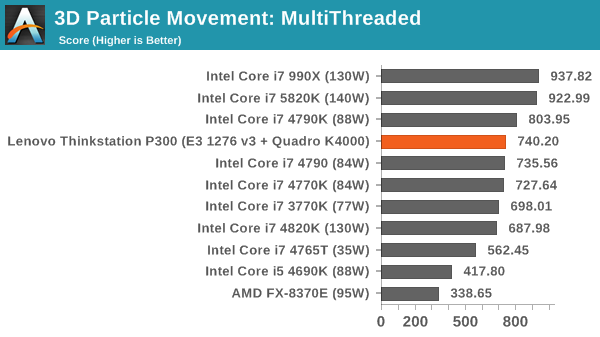
Compression – WinRAR 5.0.1: link
Our WinRAR test from 2013 is updated to the latest version of WinRAR at the start of 2014. We compress a set of 2867 files across 320 folders totaling 1.52 GB in size – 95% of these files are small typical website files, and the rest (90% of the size) are small 30 second 720p videos.
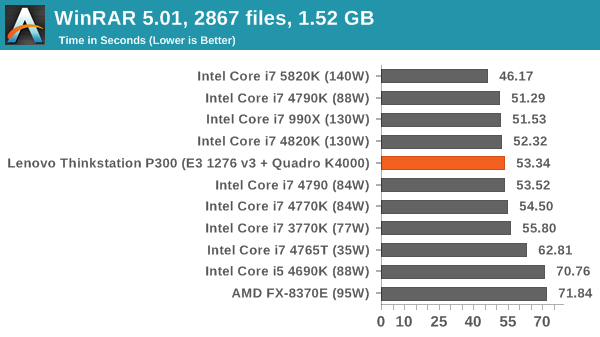
Image Manipulation – FastStone Image Viewer 4.9: link
Similarly to WinRAR, the FastStone test us updated for 2014 to the latest version. FastStone is the program I use to perform quick or bulk actions on images, such as resizing, adjusting for color and cropping. In our test we take a series of 170 images in various sizes and formats and convert them all into 640x480 .gif files, maintaining the aspect ratio. FastStone does not use multithreading for this test, and thus single threaded performance is often the winner.
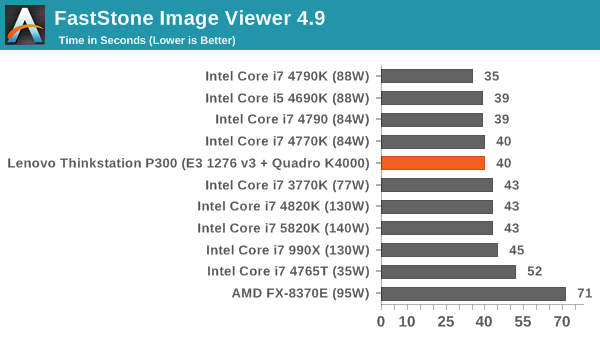
Video Conversion – Handbrake v0.9.9: link
Handbrake is a media conversion tool that was initially designed to help DVD ISOs and Video CDs into more common video formats. The principle today is still the same, primarily as an output for H.264 + AAC/MP3 audio within an MKV container. In our test we use the same videos as in the Xilisoft test, and results are given in frames per second.
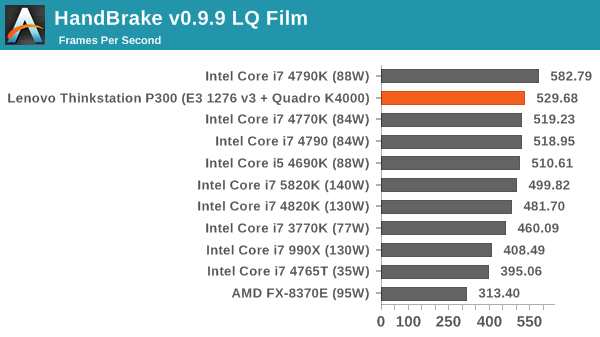
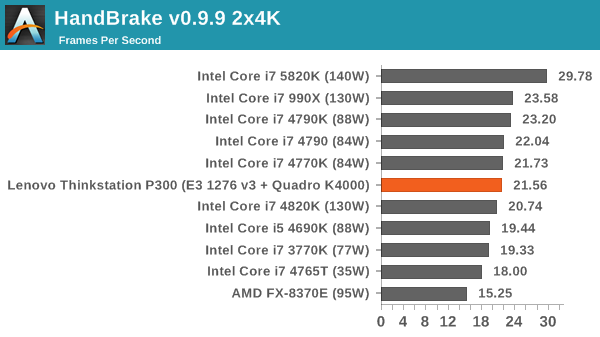
Rendering – PovRay 3.7: link
The Persistence of Vision RayTracer, or PovRay, is a freeware package for as the name suggests, ray tracing. It is a pure renderer, rather than modeling software, but the latest beta version contains a handy benchmark for stressing all processing threads on a platform. We have been using this test in motherboard reviews to test memory stability at various CPU speeds to good effect – if it passes the test, the IMC in the CPU is stable for a given CPU speed. As a CPU test, it runs for approximately 2-3 minutes on high end platforms.
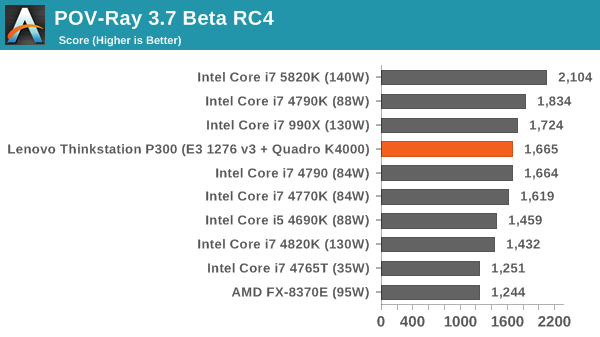










55 Comments
View All Comments
jabber - Tuesday, November 4, 2014 - link
Though I probably wouldn't buy one of these as they seem way too limited and the build quality is cheap for a Workstation.SkiBum1207 - Tuesday, November 4, 2014 - link
On the overview page, about half way down, there's a picture of the intake fan with some sort of a shroud on it - what is the purpose of the shroud? I could maybe understand an increase in velocity and static pressure, but it seems like it would cut airflow by 80% - Coming from the land of rack units where cfm is king, am I missing something here?mfenn - Tuesday, November 4, 2014 - link
I love how Ian nitpicks internal layout decision in the name of improving airflow, but fails to present any CFD modeling or empirical testing to support his viewpoints. Gives a nice sheen of "I'm an enthusiast who knows more about case design than mechanical engineers" to the whole thing. Well done!But seriously Ian, you should not make objectively provable (or disprovable) claims without providing appropriate evidence. There are definitely time considerations to take into account during the review process, and obviously everything cannot be tested if the review is to ever come out. However, in such instances, you should stick to presenting the facts and letting readers draw their own conclusions instead of adding flippant and potentially false statements to the review.
Oscarcharliezulu - Wednesday, November 5, 2014 - link
If the writer didnt add an opinion then wouldn't the article just be a spec sheet?duploxxx - Tuesday, November 4, 2014 - link
very poor design and cablingdgingeri - Tuesday, November 4, 2014 - link
a single non-ECC 8GB DIMM and a 1TB SSHD for storage, for $2274. What an incredibly overpriced piece of junk. I could build one with this same processor, a workstation level motherboard, 16GB of ECC memory, a 256GB 850 Pro SSD for the OS and a 3TB Hitachi Ultrastar (pro level) drive for storage, including the Windows 8.1 Pro license, for less than three quarters of this price. It is SO not worth $600 for Lenovo support and warranty.Gigaplex - Wednesday, November 5, 2014 - link
With what GPU? That's where the bulk of the costs went.SuperVeloce - Tuesday, November 4, 2014 - link
What the hell is this with non-standard 24pin power motherboard connector? Are they out of their minds?DanNeely - Tuesday, November 4, 2014 - link
Dunno; OTOH the target market for something like this would never service it except via waranty so it wouldn't matter; and the 24pin ATX connector is really out of sync with modern systems needs; specifically the 5x 3.3 and 5x 5v are way over what a modern system needs and unless you're doing RS232 the -12v is useless too. 3.3 is going the way of the dodo since it's only used by legacy PCI now; and USB doesn't need anywhere as much 5V as a P1 system does. Spitting the connector would theoretically help with cable management by making the bundles slimmer; and adding more spread out connection points on the board makes it easier to maintain stable voltages everywhere.Gigaplex - Wednesday, November 5, 2014 - link
Dell have started doing this again recently too. My previous Dell workstation is far more flexible than my current one. I'm also not happy with the lack of air flow over the hard drives. I've had several drive failures that might be attributed to overheating. This Lenovo looks like it has similar issues but at least it has a fan on the front.